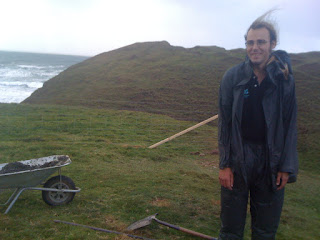In the summer of 2011 I managed to find myself
two work placements which would go towards my 100 hours needed for my
foundation degree. The first was two weeks with the North Devon Biosphere
Reserve (NDBR) based in Bideford, Devon. The second was working with the
National Trust Rangers in Bude over the summer.
 |
| The Office |
The NDBR is
a UNESCO biosphere reserve, the first of its kind in the UK. Its main roles
include maintaining coastal paths and the Tarka trail, educating the public
through volunteer days, working with the public to improve the local area and
celebrate local culture, help revive biodiversity and to work on climate change
issues, locally and worldwide.
In my time spent here I learnt how to identify
plants, surveying techniques, working with and managing the public, designing
posters, displays and map reading. The surveying included Rhinanthus minor
(Yellow rattle) and Crocosmia (Montbretia). Yellow rattle has been tried
out in hedges along the Tarka trail and in Northam as a growth control as local
councils have cut the amount of times the hedges are cut from 18 a year to 2. Montbretia
was surveyed at Spekes in Hartland and is being surveyed over a 5 year period
(2011 is the 4th year) to see how much it is spreading. At the end
of the 5 years the information collected will be evaluated to find the best method
to remove or if it needs removing at all. I also got to help work on their
Biodiversity Action plan, take photos of Braunton Borrows for a magazine
article, make public information posters on recent coppicing along the Tarka
trail and talk to Bideford College about putting up Apus apus (Common Swift) boxes.
 |
| Crocosmia (Montbretia) at Spekes |
With another volunteer I also got to
help organise and take part in a Balsam bashing day, set up to help clear some
of the Impatiens glandulifera (Himalayan
balsam) along the Tarka trail. Impatiens glandulifera (Himalayan balsam), is originally
from the Himalayas, between Kashmir and Garwhal, also known as Indian balsam
and Policeman's helmet, among others. It has since been introduced and become
widespread in Northern and central Europe, temperate North America and New
Zealand, which shows Himalayan balsam can adapt to different climate conditions
from its native home. In 1987 it was ranked one of the top twenty invasive
species in the UK. The plant was brought
to the UK in 1839 for ornamental planting in gardens, so is not a native plant
and the collapse of many rural estates introduced it from gardens and into the
wild. Himalayan balsam is an annual plant and is known to grow to around 2.5
metres which shades out other flora and can reduce their germination. It grows
very fast and is generally found on riverbanks although it has also been seen
elsewhere such as waste lands. Studies have shown it can reduce species
richness within an area by 25%.
 |
| Pulling Himalayan balsam |
Working with
Himalayan balsam was very interesting and this helped me decide on my second
year project. My time spent with NDBR was very educational. I felt I learnt how
work is really undertaken when in the work place and I would be expected to
work if I got a job in this field. It has made me more interested in plants,
especially non-native plants, after my work surveying them. I also got to
continue work for the NDBR over the summer by helping out with a beach clean
they had organised and again visiting Spekes to survey the Montbretia when it had started to flower.
 |
| Braunton Burrows |
My second work experience was with the
National Trust. This work involved more maintenance instead of surveys. The
work included beach cleans, repairing fences, painting, putting up and taking
down fences for events, making bird boxes, recycling and building a dry stone
wall. I stayed at the National Trust from July to the beginning of September,
just before my course restarted.
 |
| Dry stone wall |
I tried to pick to different work
placements so I could gain different skills and have a clearer idea of what it
is I could or want to do when my degree is finished.




No comments:
Post a Comment